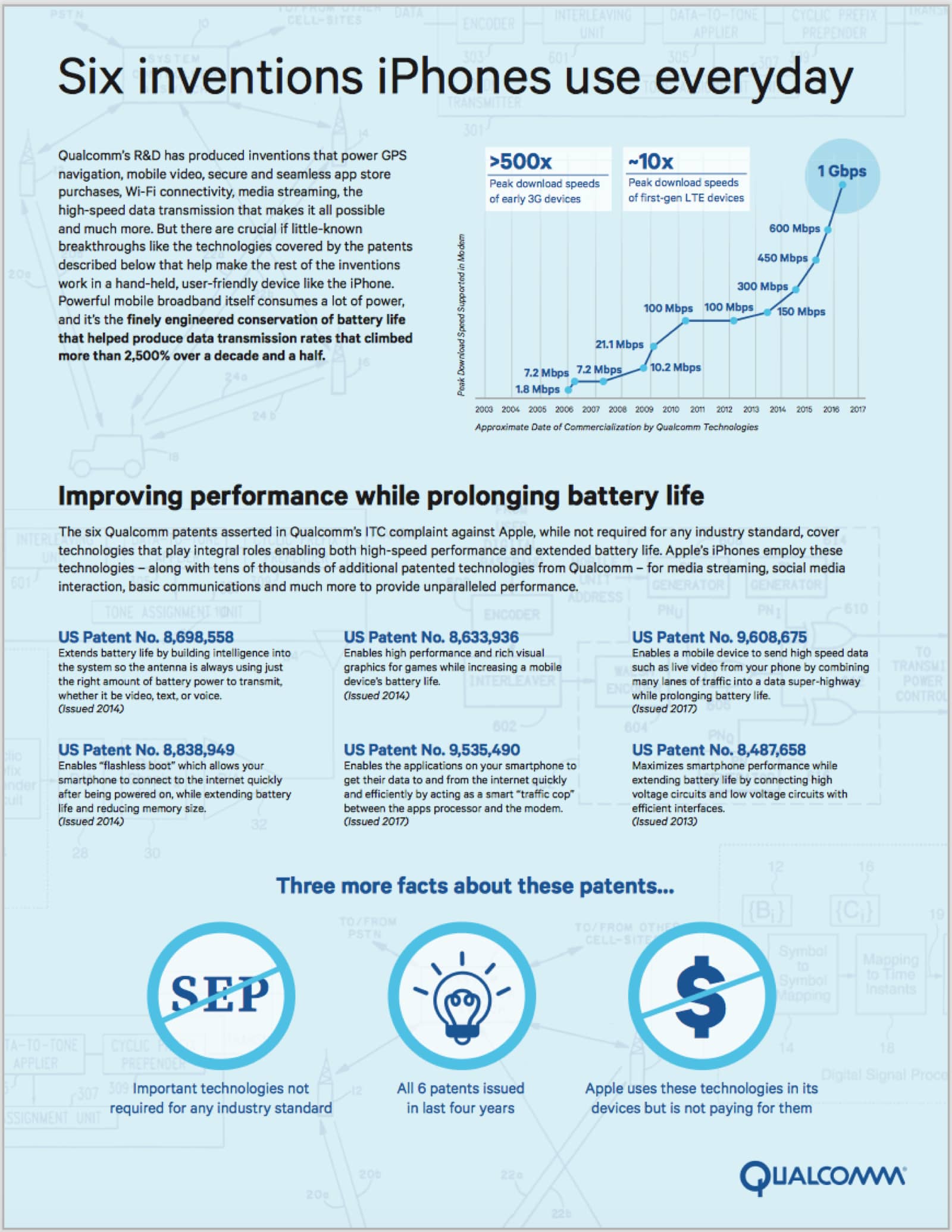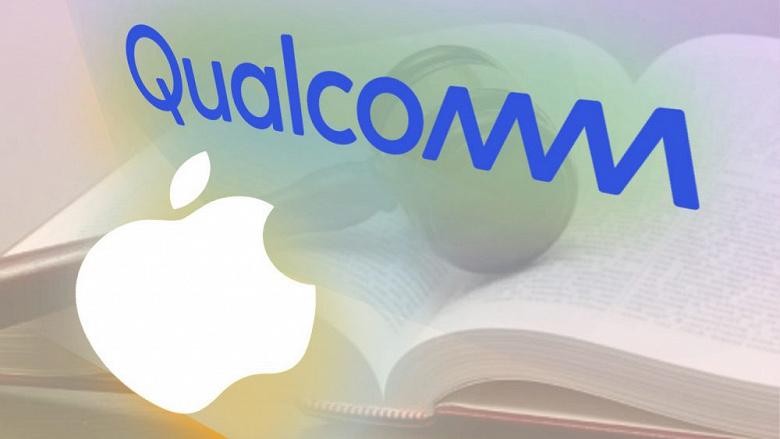Background: why Apple and Qualcomm quarreled, and then reconciled

It became known yesterday that Apple and Qualcomm came to an agreement after several years of patent disputes . Apple had to pay compensation to the partner, the amount of which is not announced. But what caused the conflict and why were both parties forced to make peace?
How did it all start?
Apple lawsuit in the US
On January 20, 2017, Apple sued the US for its partner, Qualcomm , demanding $ 1 billion from the latter in compensation for damages. According to Apple, it was that Qualcomm over the course of several years overstated the selling price of its chips, making profits illegally.
')
The lawsuit said that Qualcomm demanded a royalty from Apple at a rate of several percent of the value of each iPhone sold by the corporation. In response, Qualcomm allowed the partner to use its patent documentation. In addition, Qualcomm required that Cupertins use only Qualcomm chips, not cooperating with other companies. A document compiled by Apple for the court stated that this situation lasted several years - from 2011 to 2016.
In turn, Qualcomm said that Apple’s allegations are groundless. “Apple deliberately incorrectly describes agreements and agreements with us, as well as the importance of technology created by our company,” the response document stated . The company said it would challenge Apple’s claim, and indeed did so, with the result that the investigation was delayed for two long years.
Apple suit in China
Just a few days after filing a lawsuit against Qualcomm in an American court, the Apple team went to court in China, demanding $ 145 million from the partner. products are more money than they really are.
Qualcomm did not remain silent this time either, stating that Apple was simply "trying to pay less for the technology provided by Qualcomm . " According to the chip manufacturer, the agreement with Apple did not differ fundamentally from the agreements concluded with more than a hundred Chinese companies.
Qualcomm CEO Stephen Mollenkopf told CNET in an interview that Apple is suing because it wants to pay less for company patents. But at the same time, Qualcomm does not overstate the price of its products or services - the company asks for a fair price for its intellectual property .
At the same time, the head of the chip manufacturer remarked that he would continue to ship Apple products further, despite lawsuits in two countries.
Apple suit in the UK
In the spring of 2017, Apple filed another lawsuit against Qualcomm - this time in the UK court. The lawsuit was similar to those provided by Apple to the US and Chinese courts .
Qualcomm sues back
This time the chip maker decided to file a counterclaim . The official reason is Apple’s refusal to disclose the “full potential of capabilities” of electronic components provided by Qualcomm in the new iPhone 7 phones at the time. According to the plaintiff, Apple’s reason is to use only the basic functions of the chips to start working with Intel products, including modem microcircuits.
At that time, Apple released a different version of the iPhone 7, some for the first time in several years were not equipped with Qualcomm chips. This company began to accuse Apple also of the fact that the Cupertins intentionally underestimate the test results of the iPhone 7 with Qualcomm chips, saying that the performance of all models is “approximately the same”.
Who and how much lost?
After Apple decided to stop paying all royalties under contracts with Qualcomm, the latter had to cut expectations for future earnings.
"Waiting for a court decision, we suspended payments to Qualcomm," Apple representatives said.
Well, Apple had to start installing Intel's slower modem chips into their smartphones. They reduced the potential bandwidth of LTE connectivity in the new iPhone models . And that's not all - not wanting smartphones with Qualcomm chips to compare favorably with smartphones with chips from Intel, Apple artificially limited the network connection speed in all iPhone 7 . At the same time, competing phones, such as the Samsung Galaxy S8, showed higher speeds than the iPhone 7, since they had Qualcomm chips installed and there were no restrictions.
Accordingly, Samsung indicated gigabit network connectivity speeds as an advantage, and the company probably managed to get more market share than it could get without Apple clashing with Qualcomm.
Already in the summer, Apple sued San Diego (USA) with a lawsuit demanding to punish Qualcomm for using the “illegal business model” . According to the team from Cupertino, Qualcomm not only inflated the cost of its products, but also forced partners to obtain a license for patents.
Two weeks after the lawsuit, Apple has already filed a Qualcomm lawsuit against its (yet) partner . The company demanded to ban the sale of some iPhone models in the United States, claiming that their manufacturer violated a number of patent agreements. In particular, Apple was accused of violating six patents related to reducing the power consumption of the device.

Then Qualcomm demanded to stop selling iPhone in China .
Serious losses for all
This was followed by financial sanctions. A court in San Jose (California, USA) has forced Apple to pay a fine of $ 25,000 per day for failing to comply with a court request to provide evidence of Qualcomm’s guilt. According to Apple, the reason for the failure to meet the deadline was the need to prepare "millions of documents."
Qualcomm in Europe was fined $ 1.2 billion for violating antitrust laws. As it turned out, the chip maker paid Apple "billions of dollars" for the partner to work only with this company.
In the summer of 2018, Apple completely switched to chips from Intel , completely abandoning Qualcomm products. In this case, the latter provided the results of measurements of the bandwidth of the connection to the network, installed using Qualcomm and Intel modems.

A little later, a Chinese court found the Qualcomm lawsuit fair , followed by a ban on sales of iPhone 6S, iPhone 6S Plus, iPhone 7, iPhone 7 Plus, iPhone 8, iPhone 8 Plus, iPhone X. These devices, according to the court, were made with patent infringement rights, the technologies that Apple used belonged to Qualcomm.
A German court in the winter of 2018 banned Apple from selling iPhone 7, 8, and X with Intel modems. But it was allowed to sell the same device models with Qualcomm modems .
All this was the reason that the value of Apple shares from October to December 2018 fell by 34% (from $ 230 to $ 150). Apple's capitalization for the specified period of time decreased from $ 1 trillion to $ 715 billion.

Over the same period, the value of Qualcomm shares fell by 28% - from $ 75 to $ 54.
How did it all end?

Apple could not afford to continue to lose its position in the mobile device market, so it decided to make up with Qualcomm . The companies entered into a license agreement for six years, it entered into force on April 1, 2019.
Apple had to pay compensation to a partner, but nothing is known about its size.
The business community took the news of the end of the conflict with enthusiasm. Thus, Qualcomm shares rose in price immediately by 20%, due to which the company's capitalization increased to $ 85 billion.
Apple shares rose from $ 198 to $ 203 in a few days. The corporation’s capitalization is slowly approaching $ 1 trillion, amounting to $ 958.62 billion at the time of publication of the article.
Source: https://habr.com/ru/post/448756/
All Articles